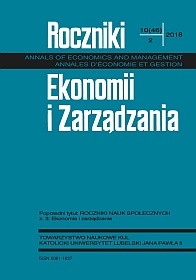Szara strefa w branży tytoniowej
Abstrakt
Szara strefa jest nielegalnym obrotem legalnymi towarami i usługami. Polska jest znaczącym producentem tytoniu i wyrobów tytoniowych. Eksport wyrobów tytoniowych pełni istotną rolę w bilansie handlu zagranicznego. Branża tytoniowa ma kluczowe znaczenie dla budżetu państwa ze względu na duży udział podatków od wyrobów tytoniowych w ogólnych wpływach budżetowych. W strukturze dochodów z akcyzy dochody z wyrobów tytoniowych wynoszą około 28%. Ze względu na niską cenę bazową wyrobów tytoniowych i duży udział podatków w cenie (około 80%) nielegalna produkcja i przemyt wyrobów tytoniowych stanowią jedną z najbardziej dochodowych działalności grup przestępczych. Celem artykułu jest przedstawienie problemu szarej strefy w branży tytoniowej oraz zmian prawnych zmierzających do jej zmniejszenia.
Bibliografia
Allen E., The Illicit Trade in Tobacco Products and How to Tackle it, “World Customs Journal” 6(2011), No. 2, pp. 121-130.
Biuletyn Statystyczny Służby Celnej, 2011-2016
Eurobarometr, http://ec.europa.eu/commfrontoffice/publicopinion/archives/eb_special_439_420_en.htm#429 [dostęp: 06.2017].
EUROSTAT 2017, http://appsso.eurostat.ec.europa.eu [dostęp: 06.2017].
FAOSTAT 2017, http://www.fao.org/faostat/en/#data/QC [dostęp: 06.2017].
Handel zagraniczny produktami rolno-spożywczymi, red. W. Łopaciuk, Wydawnictwo IERiGŻ, Warszawa 2017.
Kabaj M., Praca nierejestrowana we współczesnej literaturze ekonomicznej, „Polityka Społeczna” 2009, nr 10, s. 3.
Kraciuk J., Szara strefa w Europie, „Zeszyty Naukowe SGGW” 2013, nr 1, s. 85.
Mackay J., Erixen M., The Tobacco Atlas, World Health Organization 2002.
Metodologia badań szarej strefy na rynku usług turystycznych, red. T. Smuga, Instytut Koniunktur i Cen Handlu Zagranicznego, Warszawa 2005.
Mika B., Wszystkie odcienie szarości, w: Struktura klasowo-stanowa społeczności Poznania, red. J. Tittenbraun, Poznań 2010.
Piętka K., Szara strefa jest w świetnej formie, „Puls Biznesu”, 12.03.2004.
Poland Market Survey Top Lines Empty Discarded Pack Collection October/November 2016,Almares, Warszawa.
Przeciwdziałanie szarej strefie w Polsce, Global Compact Network Poland, http://ungc.org.pl/programy/program-przeciwdzialanie-szarej-strefie-2014-2020 [dostęp: 03.03.2018].
Rachunki narodowe według sektorów i podsektorów instytucjonalnych w latach 2012-2015, Główny Urząd Statystyczny, Warszawa 2017.
Rocznik Statystyczny Rzeczpospolitej Polskiej, GUS 2010-2015, Warszawa.
Rynek wyrobów tytoniowych – stan i perspektywy, red. M. Bodył, Wydawnictwo IERiGŻ, Warszawa 2017.
Schneider F., Ernest H.D., Shadow Economies: Size, Causes and Consequences, „Journal of Economic Literature” 38(2000), s. 77-114.
Skutki wdrożenia dyrektywy tytoniowej, red. R. Gwiazdowski, Centrum im. Adama Smitha, Warszawa 2013.
Copyright (c) 2018 Roczniki Ekonomii i Zarządzania

Utwór dostępny jest na licencji Creative Commons Uznanie autorstwa – Użycie niekomercyjne – Bez utworów zależnych 4.0 Międzynarodowe.


